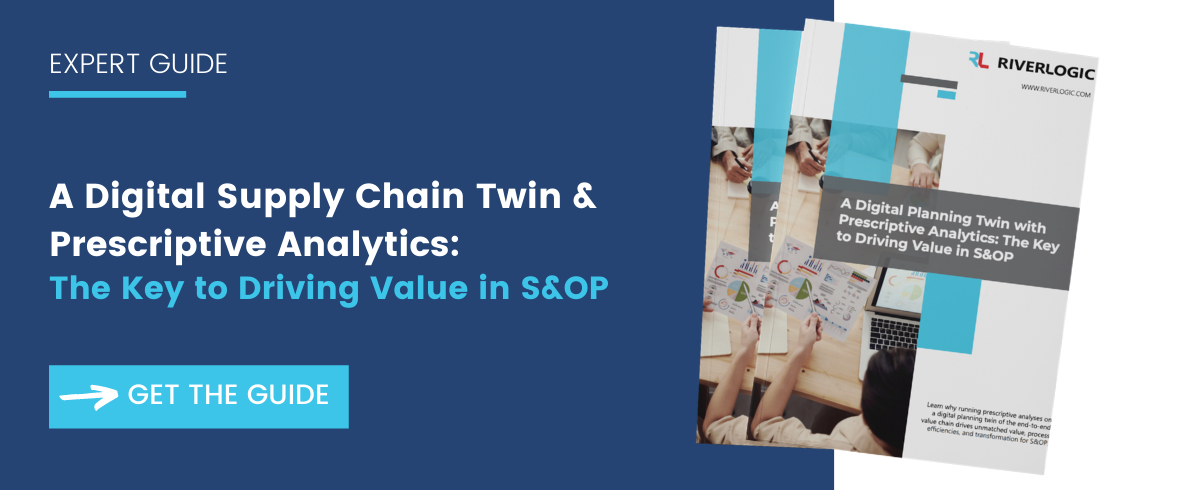Here are seven tactical planning examples supported by River Logic.
Capacity Planning
Capacity planning, sometimes referred to as rough-cut capacity planning, helps manufacturers meet anticipated demand. Key decisions include establishing what products can be manufactured and where. Do plants have sufficient capacity and are extra shifts required? Factors to consider include the need for additional capacity, toll manufacturing, the cost of extra shifts and overtime, and whether to prebuild inventory. River Logic’s capacity planning solution allows you to answer these questions, run multiple capacity planning scenarios, and establish an optimal capacity plan.
Supply Chain Planning
Supply chain planning is usually an embedded function within sales and operational planning (S&OP). It includes several analyses used to develop a complete supply chain planning picture.
River Logic’s supply chain planning solution incorporates the following planning processes:
Demand shaping
Demand shaping is used to influence demand when output is limited by capacity constraints. A key differentiator of River Logic’s demand shaping model is an ability to prioritize sales based on real profit contributions. Another is the ability to identify which demand to pursue based on margin; this is useful when supply exceeds demand.
Supply planning
Similar to capacity planning, supply planning is used to determine optimal product volume for each plant and production line to meet anticipated demand.
Inventory planning
Inventory planning determines optimal inventory levels consistent with capacity, demand, and the need to maintain safety stocks. Inventory planning answers questions such as whether there’s a need to prebuild inventory to meet periods of high demand.
Procurement planning
Procurement planning determines optimal raw material supply requirements to meet sales and manufacturing plans. A crucial factor is ensuring adequate WIP stocks are on hand for each production period and location. Points considered should include supplier lead time, shipping requirements, logistics, and toll manufacturing.
Distribution planning
Distribution planning entails determining optimal logistics routes and modes to get product to the point of demand. This includes evaluating different transportation options and routes such as road, rail, and water and whether it’s best to use in-house or contract logistics suppliers.
Budgets and financial reforecasting
Although not normally part of supply chain planning, River Logic incorporates full financials allowing you to output profit and loss forecasts by business unit, region, and time period, for input to financial planning, budgeting, performance, and analysis modules.
Industry-Specific Bonus Examples
Here are three industry-specific examples that illustrate River Logic’s tactical planning capabilities:
Process industries, optimizing product mix
In process industries such as chemicals, dairy, and mining, River Logic’s solution offers unique benefits not normally found in supply chain planning solutions. One is the ability to identify the optimal product mix at any point in time. Taking actual margins into account, this feature identifies opportunities to fine-tune production by making incrementally more or less of a specific product. River Logic evaluates the feasibility, cost, and profit of these opportunities.
Maximizing add-on capacity
In some process industries, there’s a need to consider the impact of subtle changes. For example, small changes in blending ratios might have little impact on product quality but measurably affect production cost. Another example is determining the practical and economic minimum and maximum batch quantities to improve utilization, efficiency, and performance. A third example is evaluating the benefits of buying and selling WIP inventory. River Logic offers what-if scenario analysis together with process optimization capabilities to maximize benefits from valuable capacity add-ons.
CPG, retail, and consumer health
Retailers of consumer goods, general merchandise, and consumer health products face strong competition from other companies. To increase sales, they frequently use promotions and discounts. Using advanced analytics, it’s possible to develop capabilities to optimize promotion pricing in the short term as well as to develop insights into longer-term sales and promotion strategies. This complex field requires predictive demand forecasts, lift curves, substitutions, and forward buy strategies, and it is well suited to predictive and prescriptive analytics analysis.




